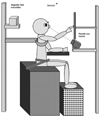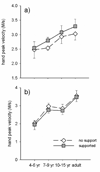Effects of postural support on eye hand interactions across development
- PMID: 17401554
- PMCID: PMC2744857
- DOI: 10.1007/s00221-007-0874-7
Effects of postural support on eye hand interactions across development
Abstract
Reaching to grasp an object of interest requires a complex sensorimotor transformation-involving eye, head, hand, and postural systems. We show here that discontinuities in development of movement in these systems are dependent not only on age but also vary according to task constraints. Providing external postural support allows us to examine the differential influences of the eye on the hand and the hand on the eye as the ability to isolate and coordinate each system changes with age. Children 4-6 years old had significant difficulty isolating eye movement from head or hand movement, whereas children 7-9 years old showed improved ability to isolate the eye, and by 10-15 years children became proficient in isolating hand movements from eye movements. Postural support had differential effects on the processes of initiation and execution of eye-hand movements. The addition of postural support decreased the time needed for planning the movement, especially in the youngest children, and contributed to increased speed of isolated movements, whereas it caused differential slowing of coordinated movements depending on the child's developmental level. We suggest that the complexity of the results reflects the complexity of changing task requirements as children transition from simpler ballistic control of all systems to flexible, independent but coordinated control of multiple systems.
Figures






Similar articles
-
Eye hand coordination in children with cerebral palsy.Exp Brain Res. 2009 Jan;192(2):155-65. doi: 10.1007/s00221-008-1549-8. Epub 2008 Oct 2. Exp Brain Res. 2009. PMID: 18830589 Free PMC article.
-
Head, arm and trunk coordination during reaching in children.Exp Brain Res. 2008 Jun;188(2):237-47. doi: 10.1007/s00221-008-1357-1. Epub 2008 Apr 5. Exp Brain Res. 2008. PMID: 18392615
-
The development of coordination for reach-to-grasp movements in children.Exp Brain Res. 2002 Sep;146(2):142-54. doi: 10.1007/s00221-002-1156-z. Epub 2002 Jul 27. Exp Brain Res. 2002. PMID: 12195516
-
Human parietal cortex in action.Curr Opin Neurobiol. 2006 Apr;16(2):205-12. doi: 10.1016/j.conb.2006.03.005. Epub 2006 Mar 24. Curr Opin Neurobiol. 2006. PMID: 16563735 Review.
-
Development of postural control in healthy children: a functional approach.Neural Plast. 2005;12(2-3):109-18; discussion 263-72. doi: 10.1155/NP.2005.109. Neural Plast. 2005. PMID: 16097479 Free PMC article. Review.
Cited by
-
Eye hand coordination in children with cerebral palsy.Exp Brain Res. 2009 Jan;192(2):155-65. doi: 10.1007/s00221-008-1549-8. Epub 2008 Oct 2. Exp Brain Res. 2009. PMID: 18830589 Free PMC article.
-
Evaluation of the effects of using a baby walker on trunk control and motor development.Turk Arch Pediatr. 2021 Jan 6;56(2):159-163. doi: 10.14744/TurkPediatriArs.2020.48742. eCollection 2021 Mar. Turk Arch Pediatr. 2021. PMID: 34286327 Free PMC article.
-
A systematic review of sensorimotor function during adolescence: a developmental stage of increased motor awkwardness?Br J Sports Med. 2012 Jul;46(9):649-55. doi: 10.1136/bjsm.2010.079616. Epub 2011 Apr 1. Br J Sports Med. 2012. PMID: 21459874 Free PMC article.
-
Children's head movements and postural stability as a function of task.Exp Brain Res. 2014 Jun;232(6):1953-70. doi: 10.1007/s00221-014-3886-0. Epub 2014 Mar 26. Exp Brain Res. 2014. PMID: 24668127
-
Open-Cup Drinking Development: A Review of the Literature.Dysphagia. 2018 Jun;33(3):293-302. doi: 10.1007/s00455-017-9871-6. Epub 2017 Dec 29. Dysphagia. 2018. PMID: 29288432 Review.
References
-
- Amiel-Tison C, Grenier A. Neurological evaluation of the human infant. New York: Masson; 1980. Evaluation neurologique du nouveau-ne et du nourrisson; pp. 81–102.
-
- Bertenthal B, Von Hofsten C. Eye, head and trunk control: The foundation for manual development. Neuroscience and Biobehavioral Reviews. 1998;22:515–520. - PubMed
-
- Biguer B, Jeannerod M, et al. The Coordination of Eye, Head, and Arm Movements during Reaching at a Single Visual Target. Experimental Brain Research. 1982;46(2):301–304. - PubMed
-
- Cordo PJ, Nashner LM. Properties of Postural Adjustments Associated with Rapid Arm Movements. Journal of Neurophysiology. 1982;47:287–382. - PubMed
-
- Epelboim J, Steinman RM, et al. Gaze-shift dynamics in two kinds of sequential looking tasks. Vision Research. 1997;37(18):2597–2607. - PubMed
Publication types
MeSH terms
Grants and funding
LinkOut - more resources
Full Text Sources
Medical

